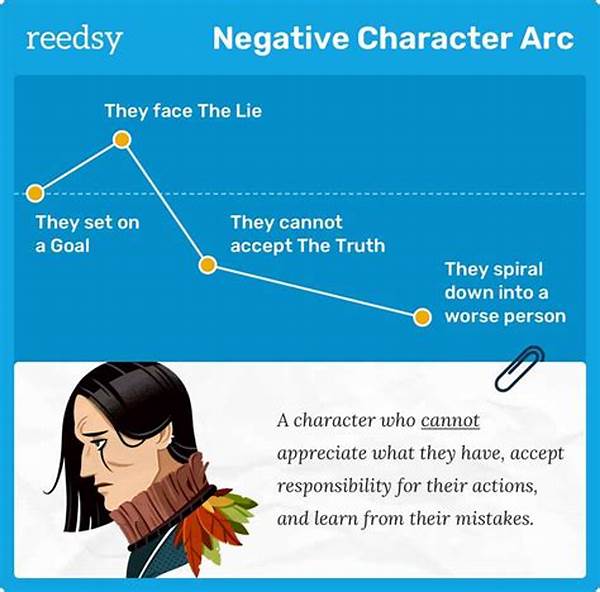In storytelling, character development is often the heartbeat of a narrative. This rings especially true when we consider emotion-driven character arcs. Characters who evolve not just through external events but through the emotional journeys they undertake, resonate deeply with audiences. These arcs are crafted with care to ensure that the characters seem genuine and relatable, offering readers or viewers a sense of connection and transformation that feels authentic.
The Power of Emotion in Storytelling
Emotion-driven character arcs leverage the intricate layers of human emotions to depict growth. These arcs focus on how characters respond internally to challenges, triumphs, and failures. Often, a character’s emotional journey is intertwined with their external journey, creating a rich tapestry of narrative depth. For instance, a hero’s outward battle with an adversary may reflect their inner struggle with self-doubt, and only by overcoming internal obstacles can they achieve victory. Such arcs captivate audiences because they mirror real-life experiences, where change is a mix of external events and internal evolutions. In stories with emotion-driven character arcs, the audience is not merely observing change; they feel it alongside the character.
Emotion-driven character arcs can transform ordinary plots into extraordinary tales. A character’s internal transformation — from fear to courage, despair to hope — captures the essence of storytelling that resonates on an emotional level. These arcs allow audiences to witness the raw, unpolished aspects of life and human nature, fostering a deep investment in the characters’ journeys. By focusing on the emotions that drive characters, writers can craft narratives that engage, inspire, and linger in the minds of their audience long after the story concludes.
Key Elements of Emotion-Driven Character Arcs
1. Believability: Emotion-driven character arcs must be realistic to be effective. Characters should exhibit clear reasons for their emotions and transformations, grounded in relatable experiences.
2. Complexity: Successful arcs encompass a wide range of emotions, portraying the multifaceted nature of human behavior. Characters evolve through joy, sorrow, fear, and resolve.
3. Engagement: When characters’ emotional journeys are compelling, audiences invest emotionally. This connection motivates readers or viewers to follow the arc through to its resolution.
4. Resonance: Emotion-driven character arcs leave a lasting impact by connecting with universal human experiences. They often touch on themes like love, redemption, and identity.
5. Growth: The ultimate goal of such arcs is character growth. This development feels earned and significant when driven by the character’s internal realization and change.
Crafting Emotion-Driven Character Arcs
Creating emotion-driven character arcs requires a balanced approach. Writers must weave emotions into the fabric of the narrative, seamlessly integrating emotional highs and lows with the storyline’s physical events. The key is to ensure that emotional changes are consistent with the established character traits and believable to the audience. This often means diving deep into a character’s psyche to explore their fears, desires, and motivations.
When emotions drive a character’s trajectory, the narrative naturally leans toward significant turning points that demand emotional reflection and response. The challenge lies in pacing — plotting these emotional beats so that they coincide effectively with story events. Proper integration ensures that arcs do not feel forced but rather unfold organically, echoing the natural progression of real-life growth.
The Importance of Emotional Authenticity
A natural sounding language in emotion-driven character arcs is crucial. It provides a sense of reality that transports the audience into the story’s emotional landscape. Authenticity in expressing emotions ensures that character arcs are relatable, offering audiences a mirror through which they can see their own complexities.
Emotion-driven character arcs achieve authenticity by avoiding clichés, opting instead for genuine expressions of emotion. This involves showing characters’ reactions and decisions that align with their established personality traits and backstory. Words and actions should flow naturally from the character, revealing their growth in an authentic manner that captures the reader’s or viewer’s imagination and empathy.
Emotion-Driven Character Arcs: A Case Study
When examining successful implementations of emotion-driven character arcs, certain stories shine brightly as examples. Let’s dissect a well-known narrative, where characters change through deeply emotional experiences, illustrating the power of these arcs.
The protagonist’s journey through vulnerability and eventual empowerment is a profound emotional evolution. Initially depicted grappling with insecurities, they embark on a path of self-discovery, fueled by significant emotional events such as love, loss, and betrayal. These pivotal moments are not superficial plot devices but serve as catalysts for internal transformation, with emotion driving each decision and personal revelation.
In this narrative, supporting characters also undergo subtle changes, influencing the protagonist’s arc. Their emotional exchanges are crafted with care, demonstrating how a single powerful emotion can ripple through the storyline, affecting relationships and personal growth. By endowing each character with a unique emotional journey, the story becomes a rich, multi-layered tapestry that invites audiences into an empathetic experience. Emotion-driven character arcs serve as an engine of emotional authenticity, translating complex feelings into compelling storytelling.
Conclusion: Embracing Emotion-Driven Character Arcs
In conclusion, emotion-driven character arcs represent a pinnacle of storytelling that transcends mere plot progression. When narratives are anchored by genuine emotional evolution, they resonate deeply with audiences, offering an immersive experience that lingers and inspires. Crafting these arcs demands an understanding of human emotional complexity and a dedication to authentic representation. Writers who master this art form invite readers and viewers into a world where characters grow as they do in real life, fueled by their emotions and experiences.
As storytellers embrace emotion-driven character arcs, they wield the power to touch hearts and minds, shaping stories that are remembered and cherished. By understanding the nuances of emotional manipulation and authentic portrayal, creators can build narratives that feel as real as the emotions they depict — genuine, profound, and transformative.
